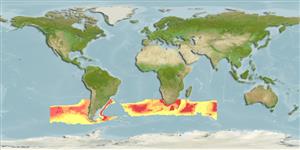(كوسه ها و سپرماهيان) (sharks and rays) >
Squaliformes (Sleeper and dogfish sharks) >
Etmopteridae (Lantern sharks)
Etymology: Etmopterus: Greek, ethmos, -ou = sieve or ethmoides bone + Greek, pteron = wing, fin (Ref. 45335).
More on author: Günther.
Environment: milieu / climate zone / depth range / distribution range
بوم شناسي
دريايي; تغييرات عمق 220 - 1620 m (Ref. 44037), usually 400 - 600 m (Ref. 124555). Deep-water; 29°S - 59°S
Indian Ocean, Southern Pacific and Southern Atlantic (Ref. 106604). Reported from off the western Cape coast but the identity of South African specimens is questionable (Ref. 127434).
Length at first maturity / Size / Weight / سن
Maturity: Lm ? range ? - 75 cm
Max length : 86.0 cm TL جنس نر / بدون خواص جنسي; (Ref. 122636); بيشينه وزن گزارش شده: 3.6 kg (Ref. 122636)
خارهاي باله پشتي (کل) : 2; خارهاي باله مخرجي: 0. A large, heavy-bodied lanternshark with a big head (Ref. 5578), bladelike unicuspidate teeth in lower jaw and teeth with cusps and cusplets in upper jaw, stocky body, conspicuous lines of denticles on body, conspicuous black markings on underside of body and tail, with tail marking short and not extending far posteriorly (Ref. 247). Dark brown or black in color, possibly darker below (Ref. 26346).
Found on outermost continental shelves and upper slopes (Ref. 247). Feeds on bony fishes including lanternfish, barracudina, synaphobranchid eels, oreo dories, hake, rattails, bathylagids, idiacanthids; also on squids (including histioteuthids and ommastrephids), octopuses, euphausiids, mysids, penaeid shrimp, salps, sponges and ribbonworms (Nemertina) (Ref. 124555). Bioluminescence observed, with the dorsal photophores, flank markings, and brighter pectoral fin and claspers are likely to be used for intraspecific communications and the ventrally emitted light is likely to be used for counterillumination (Ref. 123656). Ovoviviparous (Ref. 205), with 10-13 in a litter, size at birth about 18 cm (Ref. 6871) to possibly 30 cm (Ref. 124555), Minimum depth reported taken from Ref. 247.
Ovoviviparous, with 10-13 in a litter (Ref. 6871). Size at birth about 18 cm (Ref. 6871). Distinct pairing with embrace (Ref. 205).
Compagno, L.J.V., 1984. FAO Species Catalogue. Vol. 4. Sharks of the world. An annotated and illustrated catalogue of shark species known to date. Part 1 - Hexanchiformes to Lamniformes. FAO Fish. Synop. 125(4/1):1-249. Rome, FAO. (Ref. 247)
وضعيت در فهرست قرمز IUCN (Ref. 130435)
خطر برای انسان ها
Harmless
استفاده انسانی
ماهي گيري – شيلات: از بی علاقه گی
ابزارها
گزارش های ويژه
بارگيری XML
منابع اينترنتي
Estimates based on models
Preferred temperature (Ref.
123201): 1.7 - 9.2, mean 3.2 °C (based on 174 cells).
Phylogenetic diversity index (Ref.
82804): PD
50 = 0.5000 [Uniqueness, from 0.5 = low to 2.0 = high].
Bayesian length-weight: a=0.00363 (0.00291 - 0.00454), b=3.08 (3.02 - 3.14), in cm total length, based on LWR estimates for this species (Ref.
93245).
Trophic level (Ref.
69278): 4.2 ±0.2 se; based on diet studies.
جهندگی (Ref.
120179): پايين ، كم, كمينه زمان لازم براي دو برابر شدن جمعيت 5/4 – 14 سال (Fec=10).
Fishing Vulnerability (Ref.
59153): Moderate to high vulnerability (54 of 100).
Climate Vulnerability (Ref.
125649): Low to moderate vulnerability (27 of 100).
Nutrients (Ref.
124155): Calcium = 7.13 [1.44, 36.37] mg/100g; Iron = 0.343 [0.085, 1.239] mg/100g; Protein = 19.4 [16.8, 21.5] %; Omega3 = 0.328 [0.118, 1.004] g/100g; Selenium = 12.4 [3.4, 39.9] μg/100g; VitaminA = 20.1 [4.0, 113.6] μg/100g; Zinc = 0.385 [0.186, 0.758] mg/100g (wet weight);
